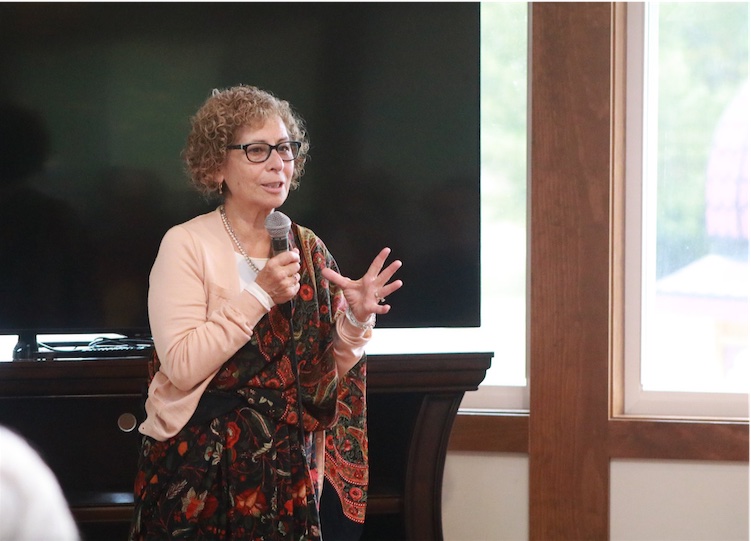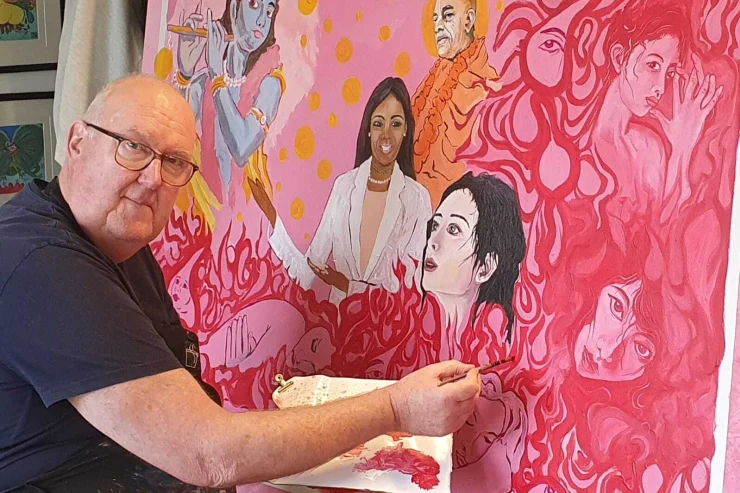40th Anniversary of Prabhupada’s Palace Brings Memories, Connection and Healing
By Madhava Smullen | Окт 07, 2019

Srila Prabhupada’s Palace is one of ISKCON’s most impressive achievements. Built by young, inexperienced devotees who trained themselves in construction and artisanal skills, it began in 1973 as a simple residence for Prabhupada. The devotees’ love for their guru, however, saw it become more and more elaborate.
Srila Prabhupada reciprocated, constantly encouraging the team and asking for reports on their progress. “I am expecting very soon to go there and live in my proposed palace at least for some time,” he wrote. He visited twice – in July 1974, when he personally thanked the devotees working on it and called them “my jewels” – and in June 1976, when the finishing work was underway.
After Srila Prabhupada left this world in 1977, the Palace became a Smriti Samadhi (memorial shrine) to him. Opening over the weekend of September 1st to 3rd, 1979, the gorgeous, ornate masterpiece was soon not only a sacred place for devotees, but also a major attraction for tourists and pilgrims, dubbed one of the “eight religious wonders to see in the United States” by CNN.

Pointing out devotees present in a special moment with Srila Prabhupada
The Palace is perhaps none more special, however, than for the devotees who built it – for them, it was a personal offering to Srila Prabhupada made with their own sweat and toil; something they actually lived.
So when over 200 devotees, including many of the original team, recently gathered at Prabhupada’s Palace from all over the USA, Canada and the United States to celebrate its 40th anniversary, there was an outpouring of stories, memories, reconnection, laughter, tears, and even healing.
The Palace Reunion Festival, held from September 27th to 29th, began on Friday evening with devotees offering a cast bronze plaque to Srila Prabhupada, commemorating the recent listing of the Palace on the National Register of Historic Places by the Department of the Interior.
The designation gives Prabhupada’s Palace a new level of prestige and national significance. Buildings are not normally eligible until they have been standing for at least fifty years. But exceptions are sometimes made for buildings of “exceptional importance” – and Srila Prabhupada’s Palace, after only forty years, was deemed such an edifice.

Nityodita Dasa offers the National Register plaque to Srila Prabhupada’s murti at his Palace of Gold in New Vrindaban
After offering the plaque, devotees carried Srila Prabhupada’s murti around his Palace, circumambulating it three times in celebration. Kirtan and a prasadam dinner followed, during which everyone reconnected after many years.
“The Brijabasi spirit was really ignited, you could feel the energy,” says organizer Sukhavaha Dasi, who served as the construction supplies manager during the building of the Palace.
On each day of the Reunion festival, devotees attended the morning program at Radha Vrindabanchandra’s temple and arati at Prabhupada’s Palace together. They also listened to classes given by Varshana Swami, Chandramauli Swami, and Chandrasekhara Swami – all residents or former residents of New Vrindaban – about camaraderie, Brijabasi spirit, forgiveness, the challenges we face in life, and the lessons we learn.
The main bulk of the celebrations on Saturday were taken up by two three-hour story sessions for devotees to share their memories. The first session, entitled “Unsung Heroines,” went to the women in an attempt to offer them special respect and acknowledge their sacrifices and the unique challenges they went through.

Vijaya Dasi shares her memories of the 1970s and 1980s
Rasalila Dasi shared how the ornate molds around the Palace were just two and a half or three feet long, and her touch-up crew had to make them all look like one seamless mold. Hours and hours had to be spent filling in each crack and division, then sanding and filing so that they appeared to be one perfect, continuous piece.
Some devotees weren’t able to attend, but their stories were shared. Rupa Rameswari Dasi, who served in the mold shop, was remembered for working so hard that her white saris always looked red from the dye used on the molds.
Tulasi Dasi shared via letter how she and Paurnamasi Dasi lay on their backs, and finished the entire ceiling in Srila Prabhupada’s bedroom in just one week using stencils, paint, and gold leaf.
Many of the women, including Lajavati, Girindra Mohini, Ruci, Ambudhara and Gopalasyapriya, taught and took care of the children so that their parents could do other services. They also did other support services such as collecting funds and cooking.

Jada Bharata shares his memories
“The women talked about the many austerities they endured,” Sukhavaha says. “You worked as hard as the men, и then you had to take care of your kids and families at the same time.”
At the end of the session, men in the audience called out praises of the women, acknowledging and appreciating specific devotees among them. Some apologized for not treating the women with respect in those days.
During the afternoon session, it was the men’s turn to share stories. Soma Das remembered when he and others were just learning to lay bricks. They began with smaller bricks, working their way up to bigger and heavier blocks, which were harder to maneuver. Gradually, they built up speed. The leaders then offered them a challenge – if they could do a hundred blocks in one day, they would get the entire four o’clock maha prasadam offering.
Needless to say, the crew pulled it off. Eventually, they worked up to the point where they could lay four hundred blocks in a single day.

Some of the builders of Prabhupada’s Palace gather in front of their labor of love to celebrate 40 years since it first opened
Meanwhile Jada Bharat Das recalled building archways with the late Devadatta. One day, evening had fallen, and they were stepping back to admire their handiwork. It looked so beautiful, and they were so overcome with inspiration to make this offering to Srila Prabhupada, that Jada Bharata turned to his co-worker and said, “How much fuel do we have left in the loader?”
“Well Jada,” Devadatta replied, “We have a full tank. What do you think? You wanna keep going?”
The two then worked all night without stopping, with only the skid loader’s lights to see by. The next morning, when the other devotees arrived, they saw an entire wall that hadn’t been there before.
Kumar Das shared how many of the things the crew were making had never been done before in America. For instance, when they made a swan boat, there was no model, so they had use their creativity to figure it out. Many of the men also talked about how they had learned lots of skills while building the Palace that they used for the rest of their lives – Marudeva, for example, was one of the main welders and is still doing wrought ironwork professionally in the local town of Wheeling.

Devotees share memories outside the original New Vrindaban farmhouse
Other devotees who shared stories included Tejomaya, Dayavira, and Jalakolahali, who worked on the construction crew; Puskar, who represented the artists, Janahlada, who trucked in all the marble and cement; Garga Risi, who worked in the mold shop, Ekachakra, who served in the woodshop; Chandrashekhara Swami, Chandramauli Swami, and Nityodita, who collected funds; Varshana Swami, who manned the heavy vehicles; and Gopisa, who welded the gates just before the Palace opening.
Devotees who were very ill, such as Sudhanu and Jaya Murari, and those who couldn’t attend, like Ghostabihari, were also mentioned and honored, as were some who had passed away such as Devadatta.
On Sunday, the final day of the festival, other men and women who had not spoken yet shared their stories. To conclude, everyone stood in a circle, held hands, and took turns speaking one word that described the experience of the weekend for them. These included, “grateful,” “blessed,” “inspiring,” and “healing.”
As they had throughout the festival, all the devotees then ate outside under tents set up on the Palace grounds, continuing to share their neverending wealth of stories. The grand finale was a kirtan in Prabhupada’s Palace.
Afterwards, many expressed to organizer Sukhavaha how much the reunion had meant to them
“Thank you for somehow getting us all together! A miracle! What a unique crew that Krishna brought together to break ground for the foundation of a holy dhama. Love to you all,” wrote Garga Risi Das.
Jnanendra said, “We had wonderful experiences meeting our old Brijabasi friends,” while Kamagiri Dasi wrote, “The Palace anniversary was fabulously, transcendentally satisfying to the heart and soul.”
“There was a camaraderie amongst all of us, that everyone could feel, almost as if we were war veterans,” adds Sukhavaha. “And you know what? People ask us, ‘How did this happen? You didn’t know anything about construction – how did you build this Palace?’ Well, here’s the truth – it was becausewe didn’t know anything, and were just praying and depending on Krishna and Srila Prabhupada so much, that the miracle of this Palace came to be.”















